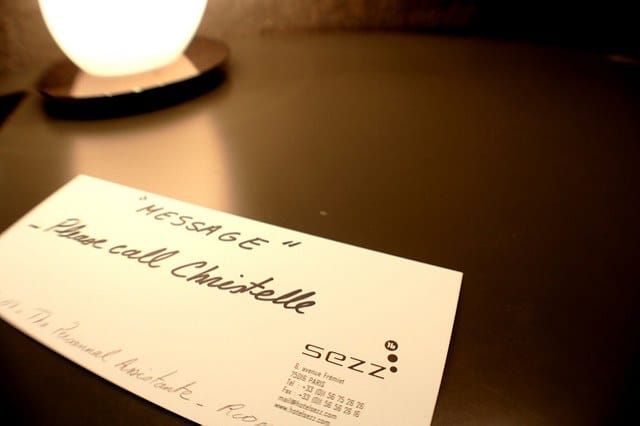We’ve all been on the receiving end of a phone message that was delivered incorrectly. If it weren’t so, than The Game of Telephone never would have been created. You know the one, right? The first player relays a message to the second, whispered in their ear. The second whispers it to the next player in line with no repeats. it continues this way through several other people. As the message goes through each set of lips and ears, it changes. After it is whispered to the final person, they say what they think the message was, and everyone gets a good laugh. Because it’s often so wrong. It changed little by little with each listening ear.
Outside of the game of telephone, the same problem comes up. Was it Cheryl who called or Sherry? Shirley? There wasn’t any whispering. There was only one person between the caller and the person who the message was intended for. But there was plenty of opportunity for some confusion.
What happened?
The person taking down the message could have failed to communicate the right message. They could have forgotten to get a name. Or, worse, a return phone number. Taking a phone message is much more than just getting down basic information. It seems like a small part of the whole small business pie. It can fall through the cracks. But it isn’t. Taking down a message incorrectly can mean no call-back for that person. You could potentially ruin the relationship with the person on the other end of the phone.
Slow down.
Contrary to popular belief, the goal of a phone call isn’t to get the person on the other line off the phone as quickly as possible. Not in the mind of some customers, at least. A recent study done by Gallup found that customers prefer their service to be thorough rather than quick and to-the-point. They’d much rather someone take their time and help them out, knowing the job was done correctly. This translates over to message taking as well. Yes, you have a lot of things to do, but the moment the phone rings, your attention goes to that caller.
The first step: answer the phone correctly
You wouldn’t believe the number of phone calls that are answered in an office with a simple “Hello”. That’s not quite professional. When someone is contacting your business, they should be reassured of a few things when you answer the phone.
Whose number did they call?
The first is that they’re calling the right number. If your business has a name that it operates under, it should be identified. If you are the owner of a small company that is under your own name, that should be identified.
Example: “This is Bob Smith’s Office…”
Who are they speaking to?
After you identify the place of business, you should identify yourself. It’s important that the person calling in knows who they are talking to. It helps them to personalize with you right off the bat. You should also put your name into a sentence. That is, don’t just say “I’m Ben”. Instead use, “My name is Ben.”
Example: “This is Bob Smith’s office, my name is Ben…”
What are you going to do for them?
Then, once you communicate the name of the business and what your name is, this is when you ask the all important question: “How can I help you?” Instead of using the traditional phrase, adding the word “today” to the mix is surprisingly effective. This is a way of saying “I have intentions of helping you right now” as opposed to “How can I help you whenever I get around to it.”
Example: “This is Bob Smith’s office, my name is Ben. How may I help you today?”
Find out whom the person is calling and what you can do to help
If the caller asks for someone who is not in the office, don’t apologize. Even if it seems like the most natural thing to do. Sorry is an overused word. No matter how sincere it is, it just doesn’t communicate the message. It’s better to not say it at all. In this case, use “Unfortunately”.
Example: “Unfortunately, Bob isn’t in his office right now.”
Don’t immediately offer to take a message
This is where many people start to take the wrong turn. Once they let the caller on the other end of the phone know that who they’re looking for is not available, people go right for the “Can I take a message?” approach. This eliminates the opportunity for you to answer the caller’s question without the need to take a message at all. Instead of offering to take a message at this point, inquire how you can be of assistance.
Be certain to frame it as an open ended question and not a Yes or No question. Don’t use “Can I help you?” The caller is more likely to say “No”, especially since they aren’t sure that you can help at all.
Example: “Unfortunately, Bob is not in the office right now. What can I do to help?”
Now, listen patiently.
It may be obvious early on in the conversation that you won’t be able to help this person directly. Or, that you will need to take a message. No matter. Continue to listen until the caller is done speaking about their issue. Don’t interrupt the person on the other end of the line, no matter how quickly you make this realization. Listen intently to what they’re saying. Use this opportunity to take notes. The brain can forget important details, and it’s one of the little details that could be essential information when it comes time for taking a message.
When you realize the reason for the call, and the caller has thoroughly explained themselves, repeat the issues back to them.
“So, just so I’m clear, you’re calling in for Bob because he left you a message about an appointment that you have tomorrow. You want to confirm that with him? Is that correct?”
Do whatever you can to resolve the caller’s reason for phoning in
If the call is about an appointment confirmation, an email that they are waiting for, or something simple that you can do to help them, take the time to do it. Lose the phrase “It’s not my department.” Resolve the problem if you know how to address the caller’s reason for contacting you. The goal is to resolve the issue with one phone call. Eliminate the need for them to get a call back at a later time. The more quickly you can resolve a caller’s issue, the more reliable and valuable your company is to them.
Isn’t that a little extra?
You might consider this as going out of your way, and it might be. Even so, being able to help a customer who didn’t expect to be helped at all gives them a sense of faith in your service and your business as a whole. No matter how small the help that you provide to the customer, it could be a deciding factor in their decision to continue to do business with your company. It’s not about the size of the favor, it’s about the thought behind it. Don’t think something as small as taking a message can make a difference?
Consider the following.
Rackspace is a small business that manages web hosting. A technical support representative was on the phone with a customer doing an intense troubleshooting session. The rep heard someone in the background of the phone say that they were getting hungry. Here’s how she explains what happened next:
“So I put them on hold, and I ordered them a pizza. About 30 minutes later, we were still on the phone, and there was a knock on their door. I told them to go answer it because it was pizza! They were so excited.”
Do you need to order a pizza for every customer? Absolutely not. But this is something that the customer never would have expected. When a person is leaving a message, they don’t expect you to be helpful nor do they think you’re sincerely concerned with their issues. It’s little acts like these that make a big difference.
If necessary, take a message. Make sure you do it correctly.
Once all efforts of assisting the caller are exhausted, you may need to take a message. If this is the case, then your goal is to set the caller up to be helped on the very next phone call. You have to get the right amount of information that enables whom you’re passing on the message to understand the nature of the call.
Here is the information that should be included in each and every phone message that you take:
For each message, obtain the caller’s:
- First and last name
- Primary Contact Number
- Cell phone Number (if different than primary)
- Email Address
- Best time to contact them back
- The reason for their call, be specific
First and last name
Ensure that they spell it out. Don’t assume that you know how to spell the name. If it’s a recognizable name, just spell it verbally to them. “Ann, A-N-N, right?” Have them spell their last name as well.
Primary Contact Number
Once they give you that phone number, ask them if that’s their home number or work number. Write that down on your message.
Cell Phone Number
If their primary contact number was not their cell number, politely ask them for their cell phone number.
Email Address
A large amount of business is handled through email. If you have an email address listed for the caller, ask them to confirm it. Don’t read it to them and ask them to answer “yes” or “no”. This greatly increases the likelihood that they will confirm even an erroneous email. Have them tell you their email address and match it to your records. Or, add it in if you don’t have one at all.
Best Time To Contact
Ask the caller for a few specific times that are good to contact them back at. If possible, get an early morning time as well as an afternoon time. Try to schedule the call at a time that’s convenient for the person that you’re taking the message for. If you know for a fact that Bob isn’t in the office from 12-3 most days, ask the caller if there’s an earlier morning or later afternoon time that would work for them. Don’t just get the part of the day (morning, evening, etc.), narrow it down to a specific time. Treat it like an appointment. This ensures the caller that you’re taking their message seriously and are scheduling them a time to be helped.
The Reason For The Call
You likely have addressed this already, however you want to read it back to them as you’re writing it down to ensure accuracy. This is a perfect opportunity for the caller to add any last minute details that they may have forgotten to tell you when you initially asked them.
Read all information back to the caller
Things happen. Mistakes are made. You may have misheard part of their phone number or email address. For the sake of accuracy, read back the information to ensure that you have it written correctly. Remember, since you are unable to resolve their reason for calling during this call, it’s your responsibility to make sure that their issue is resolved during the very next contact with them.
Reassure and Reoffer to help
Before you end the call, reassure the caller that you’re going to deliver the message to the correct person. Make clear that you’ll have the person they were looking for reach out and contact them at the agreed on time.
As a final effort to resolve their issue, or any other issues, ask “What else can I help you with today?” Again, don’t pose this as a yes or no question. Invite them to have a dialogue. If you can’t help them, then they’ll tell you so. However, this is an opportunity to help them with something you actually do have power over. It might be something as simple as a question about their account, or a general product question.
Whatever it is, do your absolute best to help them. This also builds value in the company. You might not have been able to solve their initial reason for calling, but you did answer a few questions that they might never have asked had you not offered.
End the call
Wish the caller a nice day and express to them that you appreciate their phone call and business. Remind them of your business hours and that they’re welcome to contact you back for anything that they need.
And don’t forget to deliver the message!
You’d be surprised at how many people put in a lot of work of taking a message and then forgetting to hand the message over. The message ends up as a draft message in their email or as a random post-it note on their desk. Before you start another task or take another phone call, use your company procedures to determine how you deliver the message. Compose and send the email. Add it to an Outlook Calendar. Take a physical written message. Send a text message or leave a voice note. Your call isn’t completed until the message is in the hands of the person it needs to go to.
The thing you need to most remember is that by answering a phone, you have a responsibility to represent the company that you’re working for. There isn’t time for you to be caught up in your own beliefs of what your role at the company is. When you are on the front lines of communicating with potential customers and repeat customers, you have to remember that their continued business is literally in your hands.
Apply this to your small business
Create a call answering procedure. Distribute it to everyone on the team who may answer the phone. Use the tips outlined above to help you craft your procedure. Make sure your document is easy to follow, as people might need to read it on the spot.
Create Answer Cards. Tape them to all all the phones in your office. The card should have the phrase that is needed to be said when answering calls. We use answer cards for every single call we answer. Having a script or at least a starting place, really gets the ball rolling for a perfect customer experience.
If you’re too busy , or too small to worry with these details you can always hire a team of professional receptionists. To ensure that you and your company are always represented professionally.







